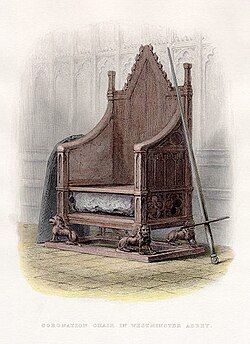Reino de Alba – Wikipédia, a enciclopédia livre
Este artigo ou secção contém uma lista de referências no fim do texto, mas as suas fontes não são claras porque não são citadas no corpo do artigo, o que compromete a confiabilidade das informações. (Junho de 2019) |

O Reino de Alba é referente ao período do Reino da Escócia compreendido entre a morte de Donald II, ano 900, e a de Alexandre III em 1286 que levou às Guerras de independência da Escócia. Alba é o nome em gaélico escocês da Escócia e é utilizado precisamente por nesta época ser a elite de cultura gaélica e mais tarde normando-escocesa, em contraposição com a época dos Stuarts na que a elite era na sua maior parte de cultura anglo.
Corte[editar | editar código-fonte]
Não se conhece a estrutura da Corte escocesa antes da chegada dos normandos à Escócia. No século XII os principais cargos da Corte eram:
- Senescal ou dapifer, hereditários desde o reinado de David I, tinha ao seu cuidado a casa do rei.
- Chanceler, tinha ao seu cargo a capela real que estava associada com os copistas reais, responsáveis de manter a documentação. Era um sacerdote.
- Chamberlain, tinha o controle e a responsabilidade das finanças reais.
- Condestável, hereditário desde David I, tinha a seu cargo os recursos militares da coroa.
- Mordomo
- Marechal, era o responsável da cavalaria real.
No século XIII, todos os oficios exceto o de chanceler tenderam a ser hereditários ao tempo que se criaram outros oficios, o mais importante era o hostarius, a cargo da guarda real.
Origem[editar | editar código-fonte]
Donald II foi o primeiro que recebeu o nome de rei de Alba (rí Alban), concretamente à sua morte no castelo de Dunnottar no ano 900. Os seus predecessores recebiam o nome de reis dos pictos ou rei de Fortriu.
Fontes[editar | editar código-fonte]
Fontes primárias[editar | editar código-fonte]
- Anderson, Alan Orr, Early Sources of Scottish History: AD 500–1286, 2 Vols, (Edinburgh, 1922)
- Anderson, Alan Orr, Scottish Annals from English Chroniclers: AD 500–1286, (London, 1908), republished, Marjorie Anderson (ed.) (Stamford, 1991)
- Gerald of Wales, The History and Topography of Ireland, tr. John O' Meary, (London, 1982)
- Guillaume le Clerc, Fergus of Galloway, tr. D.D.R. Owen, (London, 1991)
- Skene, William F. (ed.), Chronicles of the Picts and Scots: And Other Memorials of Scottish History, (Edinburgh, 1867)
Fontes secundárias[editar | editar código-fonte]
- Bannerman, John, "MacDuff of Fife," in A. Grant & K.Stringer (eds.) Medieval Scotland: Crown, Lordship and Community, Essays Presented to G.W.S. Barrow, (Edinburgh, 1993), pp. 20–38
- Bannerman, John, “The Kings Poet”, in The Scottish Historical Review, V. LXVIII, (1989)
- Barron, Evan MacLeod, The Scottish War of Independence: A Critical Study, 2nd Edition, (Inverness, 1934)
- Barrow, G.W.S., The Anglo-Norman Era in Scottish History, (Oxford, 1980)
- Barrow, G.W.S., Feudal Britain, (London, 1956)
- Barrow, G.W.S., The Kingdom of the Scots, (Edinburgh, 2003)
- Barrow, G.W.S., Kingship and Unity: Scotland, 1000–1306, (Edinburgh. 1981)
- Barrow, G.W.S., “The Reign of William the Lion”, in Scotland and Its Neighbours In the Middle Ages, (London, 1992), pp. 67–89
- Barrow, G.W.S., Robert Bruce and the Community of the Realm of Scotland, (Edinburgh, 1988)
- Bartlett, Robert, The Making of Europe, Conquest, Colonization and Cultural Change: 950–1350, (London, 1993).
- Broun, Dauvit “Defining Scotland and the Scots Before the Wars of Independence,” in Image and Identity: the Making and Remaking of Scotland through the Ages, in. D. Broun, R. Finlay & M. Lynch (eds.), (Edinburgh 1998), pp. 4–17
- Broun, Dauvit, "Dunkeld and the origin of Scottish identity", in Innes Review 48 (1997), pp. 112–24, reprinted in Spes Scotorum: Hope of Scots, eds. Broun and Clancy (1999), pp. 95–111
- Broun, Dauvit, “Gaelic Literacy in Eastern Scotland between 1124 and 1249” in Huw Pryce (ed.), Literacy in Medieval Celtic Societies, (Cambridge, 1998), pp. 183–201.
- Broun, Dauvit, The Irish Identity of the Kingdom of the Scots in the Twelfth and Thirteenth Centuries, (Woodbridge 1999)
- Broun, Dauvit & Clancy, Thomas Owen (eds.),Spes Scottorum: Hope of the Scots, (Edinburgh, 1999)
- Broun, D., "The Welsh identity of the kingdom of Strathclyde, ca 900–ca 1200", in Innes Review 55 (2004), pp. 111–80.
- Davies, R.R., The First English Empire: Power and Identity in the British Isles 1093–1343, (Oxford, 2000)
- Driscoll, Steven, Alba: The Gaelic Kingdom of Scotland AD 800–1124, (Edinburgh, 1996)
- Ferguson, William, The Identity of the Scottish Nation: An Historic Enquiry, (Edinburgh, 1998)
- Gillingham, John, The Angevin Empire, (London, 1984)
- Gillingham, John, The English in the Twelfth Century: Imperialism, National Identity and Political Values, (Woodbridge, 2000)
- Hudson, Benjamin T., Kings of Celtic Scotland, (Westport, 1994)
- Lynch, Michael, Scotland: A New History, (Edinburgh, 1992)
- McDonald, R. Andrew, "Old and new in the far North: Ferchar Maccintsacairt and the early earls of Ross" in Steve Boardman and Alasdair Ross (eds.) The Exercise of Power in Medieval Scotland, c. 1200–1500, (Dublin/Portland, 2003)
- McDonald, R. Andrew, Outlaws of Medieval Scotland: Challenges to the Canmore Kings, 1058–1266, (East Linton, 2003)
- MacLeod, W., Divided Gaels: Gaelic Cultural Identities in Scotland and Ireland: c. 1200–1650, (Oxford, 2004)
- Neville, Cynthia J., Native Lorship in Medieval Scotland: The Earldoms of Strathearn and Lennox, c. 1140–1365, (Portland/Dublin, 2005)
- Oram, Richard, The Lordship of Galloway, (Edinburgh, 2000)
- Owen, D.D.R., The Reign of William the Lion: Kingship and Culture, 1143–1214, (East Linton, 1997)
- Roberts, John L., Lost Kingdoms: Celtic Scotland in the Middle Ages, (Edinburgh, 1997)
- Stringer, Keith J., "The Emergence of a Nation-State, 1100–1300", in Jenny Wormald (ed.), Scotland: A History, (Oxford, 2005), pp. 38–76
- Young, Alan, "Buchan in the 13th century" in Alexander Grant & Keith J. Stringer (eds.) Medieval Scotland: Crown, Lordship and Community Essays Presented to G.W.S Barrow, (Edinburgh, 1993)


 French
French Deutsch
Deutsch